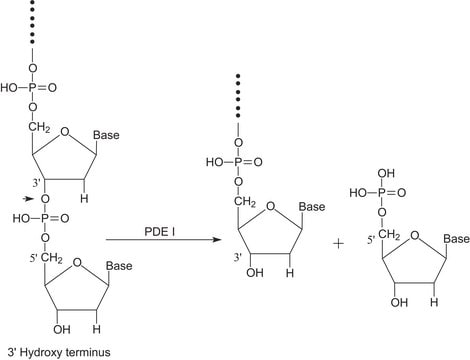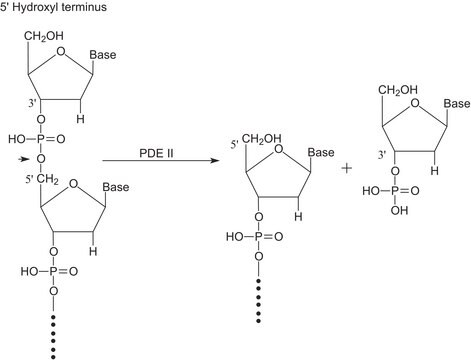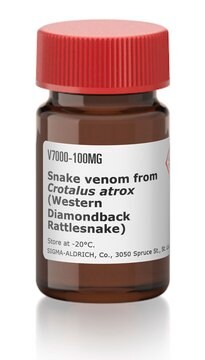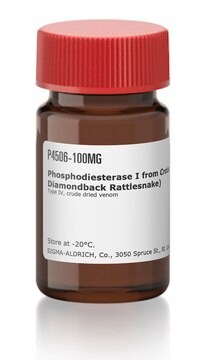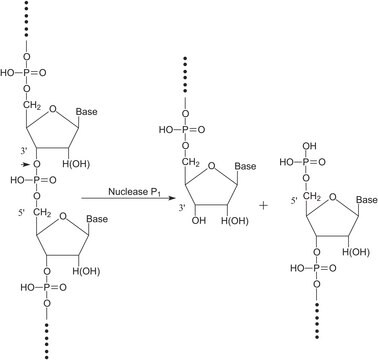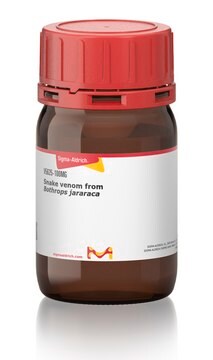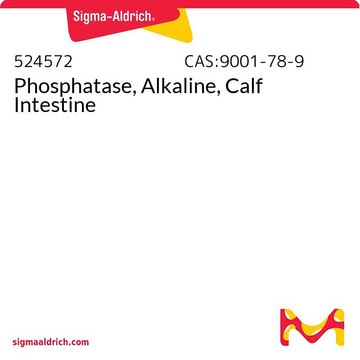P3134
Phosphodiesterase I from Crotalus adamanteus venom
Type VI, crude dried venom
Sinónimos:
5′-Exonuclease, Oligonucleate 5′-nucleotidohydrolase
Iniciar sesiónpara Ver la Fijación de precios por contrato y de la organización
About This Item
Productos recomendados
¿Está buscando productos similares? Visita Guía de comparación de productos
Descripción general
Research area: Cell signaling. PhosphodiesteraseI (PDEI) exists in three isoforms PDE1A, PDE1B, and PDE1C(2) are localized to the central nervous system, cardiovascular, and other organs.
Aplicación
Phosphodiesterase I from Crotalus adamanteus venom has been used:
- for cleaving the 3′-5′ internucleotide bonds in the linear chains of the RNA oligomers
- as a model for the hydrolysis of prodrugs in phosphodiesterase assay
- as a component in the nucleotide cleavage buffer
Acciones bioquímicas o fisiológicas
Phosphodiesterase I breaks phosphodiester bonds and catalyzes the hydrolysis of various nucleotide polyphosphates. Phosphodiesterase I is released from eucaryotic plasma membranes by phosphatidylinositol-specific phospholipase C. PhosphodiesteraseI (PDEI) can hydrolyze 3′,5′-cyclic adenosine monophosphate (cAMP) and3′,5′-cyclic guanosine monophosphate (cGMP). It binds to Ca2+/calmodulin(CaM) that lead to the stimulation of its catalytic activity.PDEIacts as a biotherapeutic for the treatment of cancer, heart diseases,pulmonary, metabolic, neurocognitive, renal, endocrine abnormalities, andneurological disorders.
Inhibidor
Referencia del producto
Descripción
Precios
sustrato
Referencia del producto
Descripción
Precios
Palabra de señalización
Danger
Frases de peligro
Consejos de prudencia
Clasificaciones de peligro
Resp. Sens. 1
Código de clase de almacenamiento
11 - Combustible Solids
Clase de riesgo para el agua (WGK)
WGK 1
Punto de inflamabilidad (°F)
Not applicable
Punto de inflamabilidad (°C)
Not applicable
Elija entre una de las versiones más recientes:
¿Ya tiene este producto?
Encuentre la documentación para los productos que ha comprado recientemente en la Biblioteca de documentos.
Los clientes también vieron
Nuestro equipo de científicos tiene experiencia en todas las áreas de investigación: Ciencias de la vida, Ciencia de los materiales, Síntesis química, Cromatografía, Analítica y muchas otras.
Póngase en contacto con el Servicio técnico